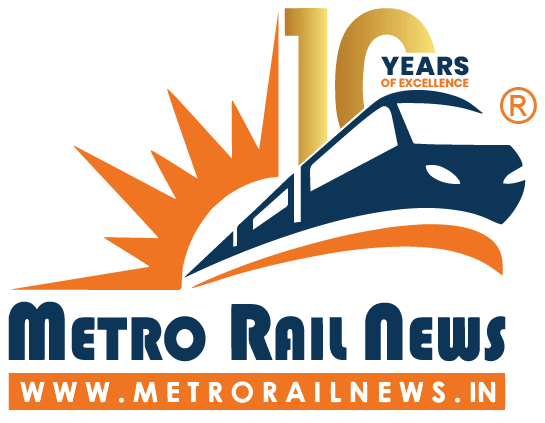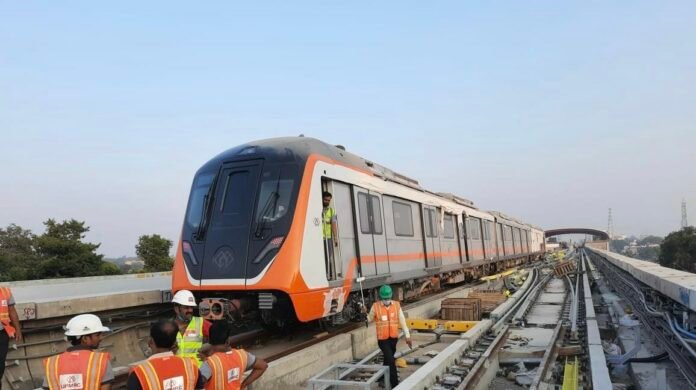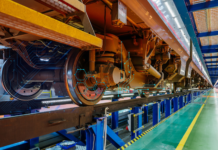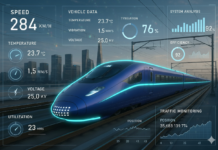Exploring Kanpur
Known as the financial capital of Uttar Pradesh, Kanpur is a large industrial city located in the central-western part of Uttar Pradesh. Founded in 1207 A.D., Kanpur is situated on the south bank of the river Ganga and is home to historical monuments such as the Jamuna Ghat, Bhitargaon Temple, Nanarao Park, and European Cemetery.
Kanpur is known for attractions such as Green Park, Allen Forest Zoo, JK Temple, and Jagannath Mandir, the city attracts many tourists. The city is also famous for its street foods such as Sultani Daal, Shami Kebabs, and Basket Chaat.
Known as India’s 12th most populous city, the 2011 census revealed Kanpur’s population to be 45,81,000 and the projected population as of 2024 is 32,86,000. The city is known for its well-established educational institutions such as IIT Kanpur. These institutions attract more students in the city and provide job opportunities to many people.

The Need for Metro in Kanpur
As of June 2017, Kanpur had the highest number of vehicles. It had 1.6 million vehicles registered under the Regional Transport Office (RTO). The concerns were on the rise for the exponential increase in the registered number of vehicles but the stagnant growth in the road network and transport facilities.
Due to the rising population and an urgent need for a safe and convenient public transportation facility in Kanpur, the Uttar Pradesh government initiated the Kanpur Metro project. The project began to make travelling around the city easy for the people.
Kanpur Metro Overview
Kanpur Metro is an under-construction urban Mass Rapid Transit System (MRTS) with 2 lines and 30 stations by Uttar Pradesh Metro Rail Corporation Limited (UPMRCL).

Approval
RITES prepared the Detailed Project Report (DPR) of 32.385 km route of Kanpur Metro. In March 2016, the DPR got approval from the state cabinet and by the central government on February 28, 2019.
The estimated cost for the project is Rs. 11,076.48 crores and 5 years were given for the completion of the project.
Funding: Phase 1 of Kanpur Metro is financed by the Government of India and the Government of Uttar Pradesh on a 50:50 basis. Also, India has taken a loan of EUR 650 million from the European Investment Bank which covers rolling stock and construction of Line 1 and Line 2 of the Kanpur metro. The loan was approved on July 15, 2020.
Opening of Priority Corridor
On November 15, 2019, the construction of the Kanpur Metro began. In December 2021, commercial operations began on 8.98 km long priority section which runs from IIT Kanpur to Motijheel. This section is a part of Orange Line.

Key Specification Of Kanpur Metro
| Speed and Track | Maximum Speed: 80 km/h |
| Average Speed: 34 km/h | |
| Track Gauge: Standard Gauge Track measuring 1435 mm | |
| Safety and Electrification | Electrification: The metro is powered by a 750V DC Third Rail. |
| Signalling: The metro system will use communication-based train control (CBTC). | |
| Rolling Stock | Alstom Transport will supply 39 trains. The trains will have CO2 sensor-based air conditioning system to ensure energy savings during the train operations. |
| Daily Ridership | As of 2024, the daily ridership of Kanpur metro is around 8000-10,000 passengers. |
| Estimated Cost | Rs. 11,076.48 crore |
| Train Length | 3 coaches |
Lines of Kanpur Metro
| Operational: 8.728 km | Under Construction: 19.357 km | Approved: 4.08 km |
- Line 1 (Orange Line): IIT Kanpur – Naubasta
- Distance: 23.8 km
- Type: Elevated (15.164 km) & Underground (8.621 km)
- Depot: Polytechnic College
- Stations (22): IIT Kanpur, Kalyanpur Railway Station, SPM Hospital, CSJM Kanpur University, Gurudev Chauraha, Geeta Nagar, Rawatpur Railway Station, Lala Lajpat Rai Hospital, Moti Jheel, Chunniganj, Naveen Market, Bada Chauraha, Nayaganj, Kanpur Central, Jhakarkatti, Transport Nagar, Baradevi, Kidwai Nagar, Vasant Vihar, Baudh Nagar and Naubasta
| Operational (8.7 km) | Under construction (15.057 km) |
| IIT Kanpur, Kalyanpur Railway Station, SPM Hospital, CSJM Kanpur University, Gurudev Chauraha, Geeta Nagar, Rawatpur Railway Station, Lala Lajpat Rai Hospital, Moti Jheel | Chunniganj, Naveen Market, Bada Chauraha, Nayaganj, Kanpur Central, Jhakarkatti, Transport Nagar, Baradevi, Kidwai Nagar, Vasant Vihar, Baudh Nagar, Naubasta |
| On July 10, the third rail system installation on the Up-line of the Chunniganj – Nayaganj section was completed. This advancement highlights the readiness of a approximately 14 km route on the up-line extending from IIT Kanpur to Naubasta. On July 12, 2024, UPMRC began a trial run of the Kanpur Metro from Moti Jheel to Nayaganj. The trial run was conducted at a low speed to test the interaction between the trains and the tracks. |
- Line 2 (Blue Line): Agriculture University – Barra-8
- Distance: 8.38 km
- Type: Underground and Elevated
- Depot: Agriculture Depot
- Stations (8): Agriculture University, Rawatpur Railway Station, Kakadeo, Double Pullia, Vijay Nagar Chauraha, Shastri Chowk Station, Barra-7, and Barra-8
- Estimated Cost: Rs. 1,025 crore
- Status: Expected to be completed by December 2025
| Elevated (5) | Underground (3) |
| Agriculture College Station, Vijay Nagar Chauraha, Shastri Chowk Station, Barra-7, Barra-8 | Rawatpur, Kakadeo, Double Pullia |
| Updates- The project will be financed through a loan taken from the European Investment Bank.Tunnelling works are expected to begin in mid-2025.Piling work of the section started on July 2, 2024. |
Kanpur Metro Project’s Timeline
| Year | Details |
| 2015 | RITES prepared a detailed project report (DPR) for Kanpur Metro after conducting the feasibility study of the project. |
| 2016 | The state cabinet approved the DPR. |
| The central government approved the DPR. | |
| 2017 | The Central government proposed a few changes in Line 1. |
| 2018 | The Uttar Pradesh cabinet approved the central inputs. |
| The finance ministry approved the Kanpur metro project. | |
| 2019 | The Uttar Pradesh government allotted Rs. 175 crore to reinforce the preliminary work of Line 1. |
| Prime Minister Narendra Modi laid the foundation stone of the Kanpur Metro. | |
| Afcons Infra was finalised to construct 9 stations of the Kanpur metro. | |
| Yogi Adityanath, the Chief Minister of Uttar Pradesh, laid the foundation of the civil work for the Kanpur metro. | |
| 2020 | The Chief Minister of Uttar Pradesh allocated Rs. 358 crore for the establishment of Kanpur Metro’s Line 1. |
| 2021 | Finance Minister Suresh Khanna made a provision of Rs. 597 crore for the Kanpur Metro. |
| Prime Minister Narendra Modi inaugurated the 8.7 km priority corridor of Kanpur Metro. The corridor is from IIT Kanpur to Moti Jheel. | |
| 2024 | The rest of the corridor of Line 1 is expected to be completed by November. |
Contractor’s List
| Contractor Name | Contract Details |
| TYPSA-Italferr JV | General Consultant |
| SYSTRA – SYSTRA MVA Consulting (India) Pvt. Ltd. JV | Detailed Design Consultant (Line 1) |
| SYSTRA – SYSTRA MVA Consulting (India) Pvt. Ltd. JV | Detailed Design Consultant (Line 2) |
| Afcons Infrastructure Ltd. | KNPCC-02(R1): Construction of IIT Kanpur – Moti Jheel |
| Sam (India) Builtwell Pvt. Ltd. | KNPCC-04: Architectural finishing at 9 stations between IIT Kanpur – Moti Jheel |
| Gulermak – Sam India JV | KNPCC-05: Construction of 3.9 km tunnels and 4 stations at Chunniganj, Naveen Market, Bada Chauraha and Nayaganj (Line 1) |
| Afcons – SAM India JV | KNPCC-06: Construction of 4.6 km tunnels and 3 stations at Kanpur Central, Jhakarkatti and Transport Nagar (Line 1) |
| Kalpataru Projects International Ltd (KPIL) (formerly JMC Projects) | KNPCC-07: Construction of 5.4 km elevated viaduct and 5 stations at Baradevi, Kidwai Nagar, Vasant Vihar, Baudh Nagar & Naubasta (Line 1) |
| KPIL – Gulermak JV | KNPCC-11: Construction of 3.2 km tunnels and 3 stations at Rawatpur, Kakadeo and Double Pullia (Line 2) |
| Ceigall India Ltd. (CIL) | KNPCC-12: Construction of 4.3 km viaduct 5 stations at Agriculture College, Vijay Nagar Chauraha, Shastri Chowk, Barra-7 Station and Barra-8 (Line 2) |
| KSM Bashir Mohammad & Sons | KNPCC-14: Construction of Agriculture Depot (Line 2) |
| Sterling Wilson – GSC JV | KNPE-1&2: 750 Volts DC Third Rail Rail Traction System, 33kV Cable Network, ASS, TSS & SCADA System |
| Larsen & Toubro | KNPAGT-3: Supply of ballastless track for Kanpur Metro |
| HFCL Ltd. | KNPAGS-1: Telecommunications (Telecom) |
| State Bank of India (Aurionpro) | KNPAFC-01: Automated Fare Collection (AFC) System on PPP |
Recent Updates
Kanpur Metro saved approximately Rs. 12 lakh in July by implementing an innovative cost-reduction model. The model involves booking slots on the Indian Energy Exchange to secure electricity at fixed lower rates with a powered source from the National Grid based on availability.
Introduction of GoSmart Card
State Bank of India and UPMRC have introduced the GoSmart Card to allow hassle-free travel to passengers. The EVM chip-based card can be recharged with a minimum amount of Rs. 100. The passengers using the card will get the benefit of a 10% discount on every ride.
Challenges Faced by Kanpur Metro
1.Low Revenue Generation
The Kanpur Metro estimated daily ridership to be around 6 lakhs around 2023-24. However, the daily ridership of Kanpur metro is 8000-10,000 passengers. This impacts the revenue of the metro and leads to losses.
2.Traffic Rerouting
Due to the construction of various metro lines, especially the elevated lines, there is a need to reroute the traffic to facilitate construction activities and avoid any accidents.
3.Increasing Demand for Line 2
Currently, the Kanpur Metro operates between IIT Kanpur and Motijheel. However, there is public demand for extending access to Line 2 (Agriculture University to Barra 8), which is still under construction. Also, Line 1 already had a well-established public transportation system and constructing a metro on that route on a priority basis did not prove to be a good move.
Benefits of Kanpur Metro
Impact on Real Estate Prices
Kanpur is one of the largest cities in India with various industrialists and businessmen. Due to the high population and private vehicles on the roads, the city experiences road congestion regularly. The Kanpur metro has helped to reduce road congestion and the real estate business to grow. The prices of properties near the stations have gone up by 8-10%.
Impact on Real Estate Prices
The Kanpur metro aims to enhance the mobility within the city. People can reach their destination on time while avoiding the traffic congestion. The metro will boost public transportation, majorly in Corridor 2 of the Kanpur metro.
Conclusion
The Kanpur Metro is a significant step towards the urban infrastructure of Uttar Pradesh’s largest and most vibrant city, Kanpur. With its intricate network of elevated and underground lines, the metro system is set to reduce the traffic congestion on the Kanpur roads. Though the project has faced challenges such as lower-than-expected ridership and traffic disruptions during construction, its potential benefits are substantial.
By enhancing mobility and reducing travel times, the Kanpur Metro aims to improve the daily lives of residents and boost economic activities. The project is also expected to have a positive impact on real estate values and contribute to a more sustainable urban environment. As the metro system continues to expand, it will play a crucial role in shaping the future of Kanpur, making it a more connected, efficient, and dynamic city.







Good work